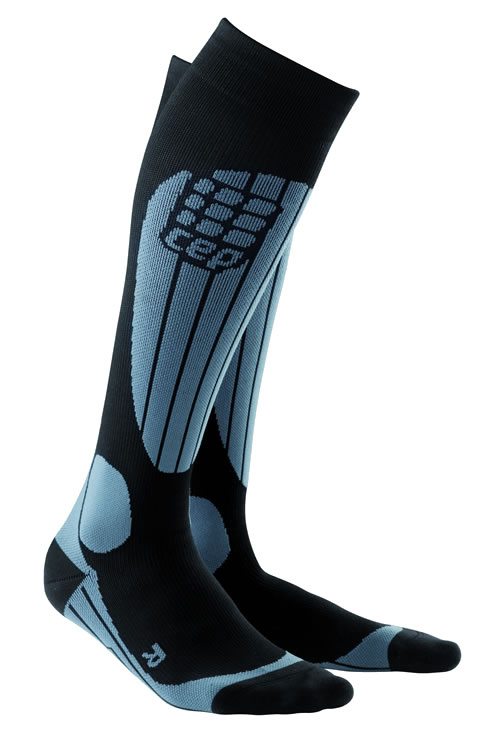CEP Wintersport Compression Socks 
FEATURES
-Achilles heel support
-Ventilation channels
-Padded sole
-Anatomically-shaped inline seams
-CellTex® Fiber finishing
-iPS® Integrated power system
-Padded Foot Soles/Shin and Ankle Area
-91% Polymaid, 9% Elasthan
MSRP: $60
Days Worn: 8
When I started researching the conditions we could expect in Niseko, Japan, I realized that it is generally quite cold in the middle of winter. The average February low temperature in the nearby town of Kutchan is -10 ˚C. Most days skiing at Niseko’s resorts on Mt. Niseko Annupuri, temperatures were a little colder than that, usually around -15 ˚C.
In my current ski boots (Nordica Supercharger Ignition with stock liner), my feet generally get numb because of the cold when the mercury dips below -5˚C, so I knew I needed to try something to keep my feet warm.
I had seen ads for CEP compression socks in ski magazines over the last few years, and I was particularly intrigued by the promises of a 40% increase in blood flow and increased warmth. With Japan’s cold weather on my mind, the claims of those ads really got my attention. BLISTER reviewers Julia Van Raalte and Jonathan Ellsworth agreed to give the socks a try, so we ordered some and put them to the test.
Again, these socks promise a lot. In addition to a 40% increase in blood flow and added warmth, the stated advantages of CEP’s compression socks include reduced muscle strain, a shorter post-exercise recovery phase, prevention of blisters, a “skin sympathetic” fabric, and enhanced performance.
I was definitely skeptical of these claims at first, but when I tried on the socks for the first time in Japan, my feet certainly felt different. It was a bit of a struggle getting the socks on, but once I had squeezed into them, my feet felt comfortable and supported. They simply felt better compared to my simple, thin Ultimax ski socks, and I was excited to see if this feeling would translate to added warmth on the hill.
I wore the CEP compression socks for my first six days in Niseko, when temperatures hovered between -15 ˚C and -20 ˚C. Unfortunately, these socks didn’t feel any warmer than my old go-to socks; in fact, they felt colder. (But keep reading, there’s an explanation coming….) I couldn’t keep my feet warm for more than a couple of runs, and many days I became seriously concerned for my feet and would go inside every two hours or so to warm them up.
Desperate to save my toes from frostnip, I opted to see how my old socks would perform compared to the CEP socks. With my old socks, my feet consistently lasted twice as long before numbness started to affect my toes. On some similarly cold days, my feet never became cold at all.
I believe this difference in warmth between socks was due in large part to their difference in thickness: The CEP socks were at least twice as thick as my Ultimax socks. With the CEP socks, I had a very tight fit in my boots with hardly any wiggle room at all, so instead of the added thickness and compression aiding my circulation (and therefore keeping my feet warmer), it seems they were compromising my circulation (which kept my feet colder).
That being said, boot liners can play a bigger role in keeping your feet warm than the thickness of the sock you use.
My four-year-old liners that I was using at first were quite packed out and therefore not as warm as they used to be. When I later tried a new, tighter liner with the CEP socks in -10 ˚C to -8˚C weather, my feet never became cold at all. The liners were painfully tight from being freshly molded the day before, but provided enough insulation to make up for any compromised circulation, and prevented my feet from ever going numb because of the cold.
Back in Breckenridge, after a -2 ˚C day with my old stock liners, my feet stayed warm and comfortable all day long (as they should at this temperature), but I still didn’t really notice a difference in the way my feet felt; but when I took off the CEP socks, I definitely noticed a difference in the way my feet looked.
With all my other ski socks, my feet generally look pretty gnarly after a long day of skiing. Usually the parts of my foot that experience higher amounts of friction are noticeably reddened, and I am able to rub off thousands of dead skin cells when I run my hand over my shins.
CEP socks are designed to prevent this kind of irritation. Or, as they say, the CellTex® Fiber finishing “facilitates the biological activation of skin cells and provides a comfortable, skin sympathetic, and climate-regulating wear.”
At the end of the day, my feet looked about the same coming out of the socks as they did going in, which was impressive. This fabric is also supposed to protect your feet against blisters, which I am inclined to believe, given how good my feet looked after using these socks.
Unfortunately, this was the only stated claim of CEP socks that I was able to verify. I had really hoped that these socks would keep my feet significantly warmer, but this was not the case. I also didn’t notice any enhanced performance or decreased muscle soreness.
That shouldn’t discourage you from trying a pair of CEP socks yourself, though. If you are looking for some really comfortable, foot-friendly ski socks you might want to keep these on your radar. With warmer liners or some more wiggle room in your boots, these socks might actually help your feet stay warmer at cold temperatures. CEP also offers a 30-day money-back guarantee on their product, so if you’re curious, I’d say the socks are worth a look.
NEXT: Julia’s Take
